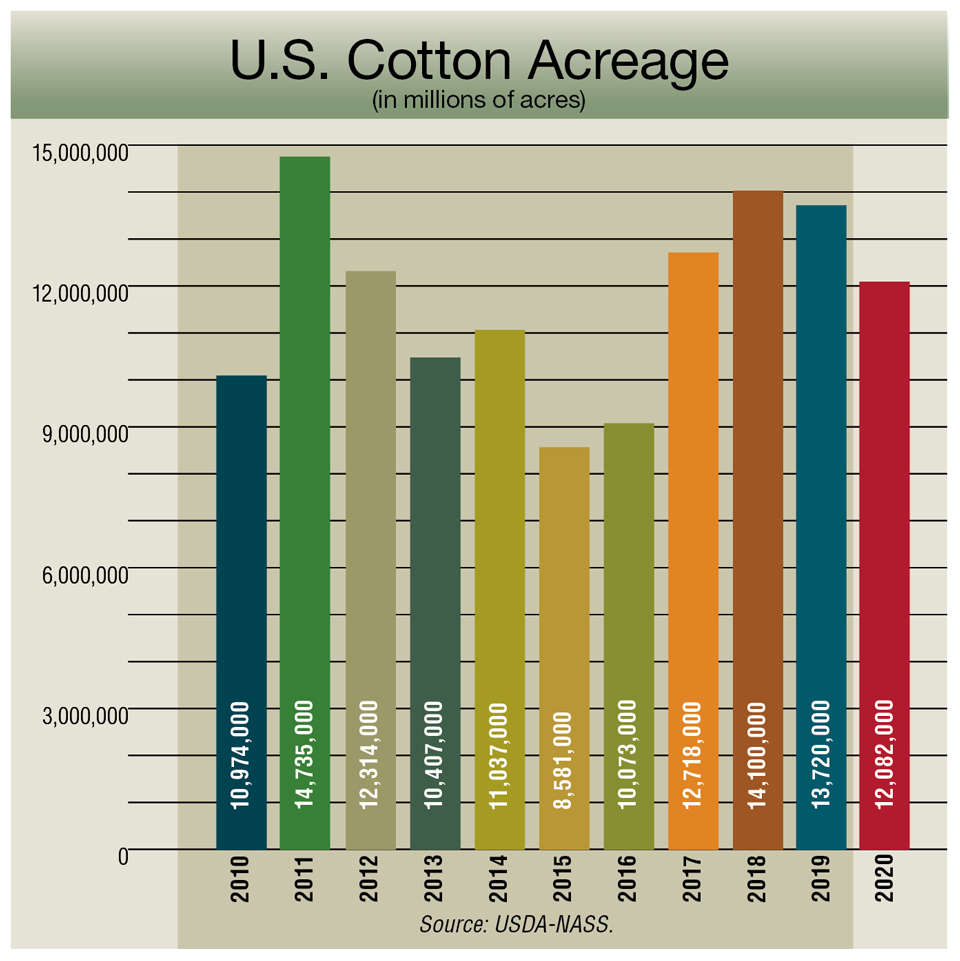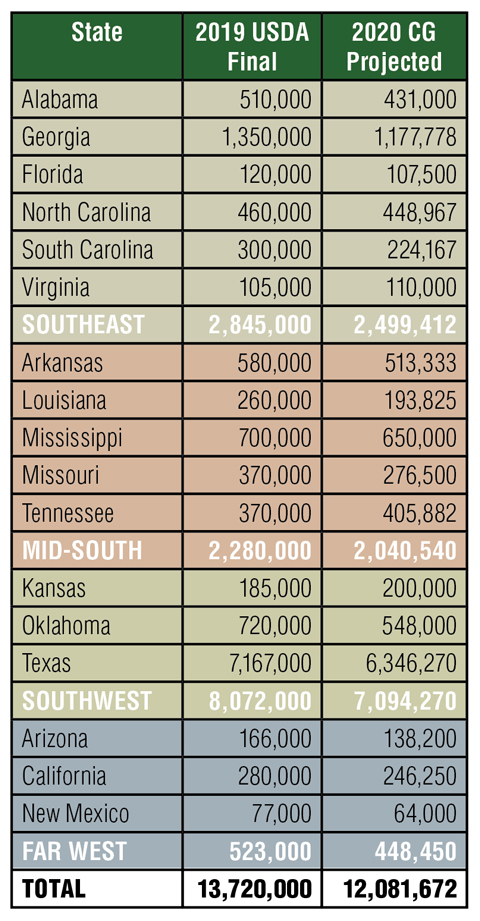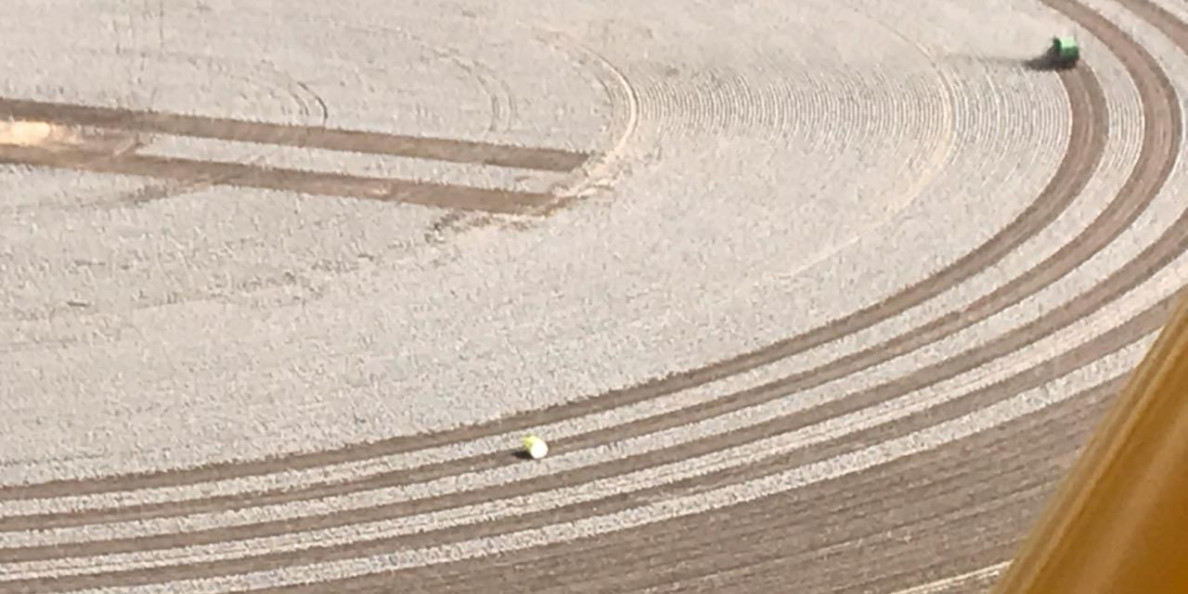By Beck Barnes
As many have predicted, cotton acres across the United States will contract in the 2020 growing season – a reflection of a farm economy that is feeling stress from a number of directions. But that drawdown in planted acres may be less pronounced than many have imagined.
American cotton producers will plant 12,082,000 acres of cotton – upland and ELS combined – in 2020 according to results from the annual Cotton Grower Acreage Survey. That number represents a roughly 12% decrease from the 13,720,000 acres they planted in 2019.
Should that projection hold true, it would represent the sixth time in the past decade that American producers have planted more than 12 million cotton acres, a strong indicator of the crop’s consistent staying power in the face of shifting market conditions and challenging headwinds.

Commodity prices are chief among the challenges cotton producers continue to face heading into 2020. Global trade disputes have disrupted an otherwise sound period of supply and demand fundamentals. Still, for many, cotton pencils out favorably compared to alternative crop options. As one state Extension specialist put it, “…the cotton gig is probably the best option for most growers.”
By region, the numbers break out this way:
- The Southwest region will once again lead the way in production acreage. Growers in Kansas, Oklahoma and Texas will combine to plant 7,094,270 cotton acres in 2020, according to the survey. The bulk of those acres come from the Lone Star State, which will once again rank first in the nation in cotton acreage. Growers there indicated they will plant 6,346,270 acres of cotton next season.
- Producers in Georgia will lead the way in the Southeast, having indicated they will plant 1,177,778 acres in the spring. As a region, the Southeast will plant some 2,499,412 acres of cotton in the 2020 season.
- In the Mid-South, producers have indicated they will plant 2,040,540 acres of cotton in 2020, with Mississippi leading the way in planting some 650,000 acres. Both the region and the Magnolia state will see slight reductions in 2020 plantings.
- California is expected to lead the way in Far West cotton plantings with just over 246,000 acres planted in 2020. Producers in New Mexico and Arizona will add to that total, bringing the Far West’s projected cotton plantings to 448,450 acres in 2020.

Penciling Out Better
The Cotton Grower Acreage Survey was conducted in November and December – shortly after most of the 2019 crop was brought in. Many respondents noted that they would be watching the markets closely over the winter months before they made a final cropping decision.
Still, if current market conditions remain stagnant (as they have through much of the previous year) cotton will be competitive with alternative crops, according to survey respondents. But prices could certainly dampen enthusiasm – even though many growers produced an excellent crop with strong yields in 2019.
“We had a good year with no major storm in the fall for much of the state,” said Guy Collins, Extension specialist with North Carolina State University. “Yields were good, and quality was good. But prices will influence growers here. It’ll take higher cotton prices to see an increase in acreage in 2020 compared to our 2019 acreage.
“Anything less than that and our acreage will stay flat or slightly down depending on where cotton prices are in the spring,” Collins said.
That trendline – flat or down from 2019 – is one that respondents echoed across the Southeast, where planted acreage is expected to fall some 13% from a year ago. Of the six states in the Southeast region, only Virginia is projected to increase acreage – a 5% bump, bringing the state’s total to 110,000.
Georgia, where peanuts and a host of other crops can compete with cotton for acreage, respondents projected a decrease of 14% from 2019. Still, the 1,178,000 acres of cotton the state is projected to grow would mean the Peach State is once again second in the nation in cotton acreage, trailing only Texas.
Southwest Sowing
The Lone Star State is on track to plant its lowest cotton acreage total of the last several years with a projection of 6,346,270 acres, though that total is still robust compared to the state’s historical cropping patterns. Elsewhere in the Southwest, cotton acreage could potentially be on the rise.
With a projection of 200,000 acres planted, Kansas represents one of only three states expected to increase acreage in 2020. While Oklahoma’s projected 548,000 acres would represent a significant decrease from 2019, there are some who sense that number could grow by the time the planters roll out into the fields.
“I’m being cautious for the 2020 estimates, but the growth reflects what will be hopefully better planting conditions, particularly in the southwest and panhandle regions, and some sustained interest in the eastern part of the state,” says Seth Byrd, Extension cotton specialist with Oklahoma State University. “If markets are favorable (which is anybody’s guess what that actually is compared to other commodities), this number could reach 700,000.”
Mixed Bag in Mid-South
Echoing the trend established across the country, Mid-South states are expected to contract cotton acreage in 2020. With a projection of 650,000 acres, Mississippi is projected to set the pace for Mid-South states, just as it did in 2019. Elsewhere in the Delta region, prices appear too much to overcome.
In Louisiana, growers can expect a nearly 30% drop in acreage, in part “due to low cotton prices, production costs are a concern, and plant bug pressure in some parts of the state,” says Dan Fromme, Extension specialist with Louisiana State University.
But further north in Tennessee, growers are feeling particularly optimistic about cotton heading into 2020. Respondents from the Volunteer State indicated they’d plant 405,882 acres of cotton in 2020, a 9% increase over 2019.
University of Tennessee Extension Cotton Specialist Tyson Raper was a bit more conservative with his estimate, although he understood his growers’ enthusiasm.
“Things are quite fluid at the moment, but lower prices have definitely reigned in excitement compared to a year ago. Still, exceptional yields from 2019 and good fiber quality will likely keep us above 300,000 (acres),” Raper says.
Steady in the West
Cotton acres in the Far West region will remain generally where they have been over recent years, with only moderate declines. California will lead the way there, with 246,250 cotton acres, according to respondents. If recent trends hold, most of those acres will be planted to Pima varieties.
In Arizona, growers are preparing to rein in acres compared to 2019, although not by much.
“I do believe that cotton acreage in 2020 will be fairly similar to our 2019 acreage,” says Randy Norton, director and Extension agronomist with the University of Arizona. “As I visit with growers across the state, they have almost all indicated that their acreage will be very similar to 2019.
“Alfalfa prices, which is the main competitor for cotton, are not all that great either,” he says.
A Fluid Situation
As always, respondents to the Cotton Grower Acreage Survey demonstrated a dynamic understanding of the forces which shape the cotton market.
Commodity prices, naturally, were the most common factor cited as affecting acreage decisions. But whether comparing to peanuts in the Southeast or alfalfa in the Far West, it seems the crop will be at least competitive again in 2020.
Other factors also played a role. Many respondents cited the cost of cotton harvest equipment – and the downstream effects of those costs – as a factor in their cropping decisions. On the positive side, the majority of those asked cited strong yields in 2019 as a reason to be enthusiastic about cotton again in 2020.


